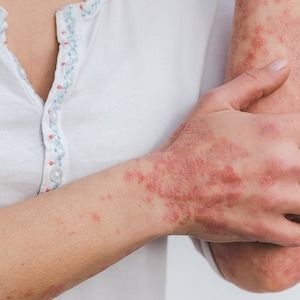Study Identifies Risk Factors for Cancer in Plaque Psoriasis Patients
A retrospective analysis of 360 individuals identified several malignancy risk factors for plaque psoriasis patients.

A retrospective analysis did not identify a statistically-significant difference in malignancy between psoriasis patients and the general population, although the researchers recommended periodic screenings for higher risk groups with psoriasis.
Those identified as being at higher risk included the following: males with psoriasis, those with psoriasis onset at older ages, those with psoriatic erythroderma, and those with poorly-controlled psoriatic inflammation.
The study was led by Tomoya Watanabe, of the Department of Environmental Immuno-Dermatology, Yokohama City University School of Medicine.
“We also observed that treatment with biological agents tends to reduce the risk of developing malignancy; however, no statistical significance was found,” Watanabe said. “These results suggest that periodic screening for malignancy should be recommended in patients with psoriasis having these risk factors and in those with poorly controlled psoriatic inflammation.”
Background
The investigators recruited 360 patients with psoriasis treated at Yokohama City University Hospital in Japan, in the period between January 2015 and March 2021. Participants’ psoriasis diagnoses had to have been made by dermatologists, and the median age range ended up being about 62.
The team gathered data on the participants such as bodyweight, sex, age, height, body mass index (BMI), medical history, age at psoriasis onset, comorbidities, laboratory data, psoriasis treatment history, psoriasis type, malignancy type, age at malignancy onset, history of smoking, and treatment outcomes.
The study group was 69.4% male (250) and 30.6% female (110), and the investigators divided psoriasis types into the following 5 titles: psoriasis vulgaris, PsA, GPP, PE, and psoriasis guttata. The participants’ malignancy rates were compared to the general population using statistics from Japan’s National Cancer Registry.
Findings
The study results identified the incidence rate of malignancy as 14.4%, or 52 out of 360 patients. The most often associated cancer was found to be colorectal cancer at 20.9%, followed then by skin cancer at 16.4%, gastric cancer at 10.4%, and then lung cancer at 10.4%.
The investigators’ age-and sex-standardized cancer incidence ratio was 1.235 (95% CI 0.952–1.601), demonstrating that while the malignancy incidence was greater for psoriasis patients with psoriasis than for the general population, there was not a statistically significant difference identified by the analysis. The researchers’ multivariate analysis demonstrated that there was a higher malignancy risk for the following groups:
- Males with psoriasis (HR = 3.15; 95% CI 1.381–7.187; P < 0.001)
- Those with psoriasis onset at older ages (HR = 1.08; 95% CI 1.058–1.111; P < 0.01)
- Those with psoriatic erythroderma (HR = 4.44; 95% CI 1.354–14.581; P < 0.05)
“This study aimed to identify the risk factors for malignancy onset in patients with psoriasis in Japan,” they wrote. “Statistical analysis revealed that older age at psoriasis onset, male sex, and PE were risk factors for malignancy development. Furthermore, we found that treatment with biological agents might reduce the risk of malignancy initiation.”
The study, “Risks of malignancies among patients with psoriasis: A cohort study of 360 patients,” was published in the Journal of Dermatology.